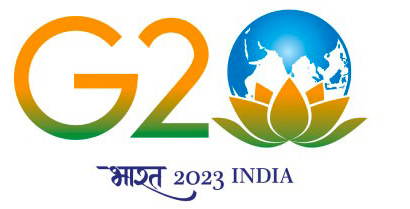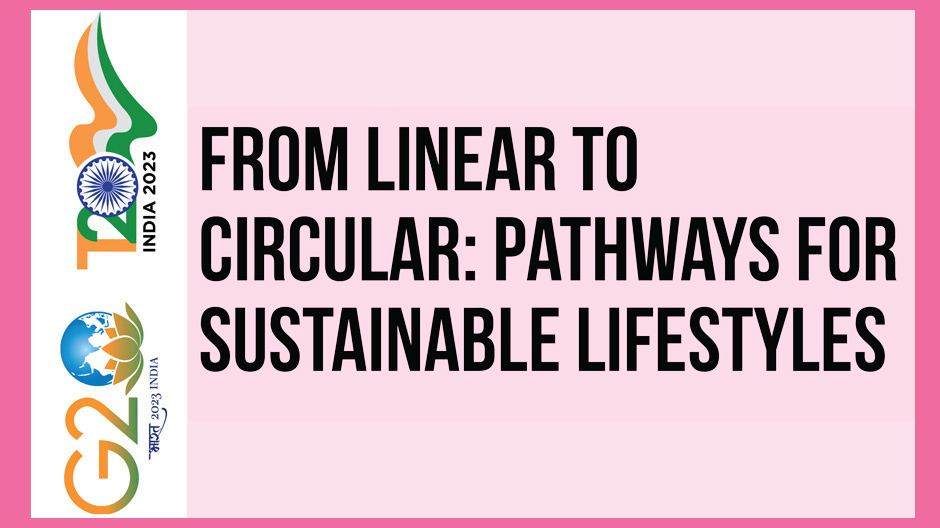Task Force 3: LiFE, Resilience, and Values for Wellbeing
Abstract
As countries around the world commit to more ambitious Nationally Determined Contributions (NDCs) to climate action, it has become increasingly important that policies deal with de-coupling economic growth and environmental degradation, and re-coupling growth with planetary and ecological sustenance. Towards this, SDG-12 (Responsible Consumption and Production) acts as the bedrock of strategies aimed at accomplishing the Sustainable Development Goals. This Policy Brief outlines pathways to nudge behaviour towards a Circular Economy approach and away from linear production and consumption. It is recommended that G20 should: (1) create partnerships and work with local communities to bring about consumer-directed behavioural shift towards zero-waste lifestyles; (2) work at arriving a standardised system for eco-labelling products and design for effective end-of-life utilisation; (3) create a platform for knowledge-sharing for stakeholders in the circular economy; and (4) create a financial mechanism for streamlining activities targeted at sustainable consumption and production.
1. The Challenge
From climate goals to long-term net-zero ambitions, the global community has declared its commitment to leave behind a healthier planet for the future generations. To fulfil these commitments, however, a change in approach is necessary: the traditional linear model of production and consumption of ‘take, make and dispose’ needs to be replaced by a circular one of ‘make, use, reuse and recycle’. A ‘circular economy’ approach aims to deliver the twin challenges of material management—i.e., increasing productivity, and reducing the carbon footprint of materials in all stages of their lifecycle. The circular economy aims to achieve four main goals. These include optimising the worth of the materials that circulate within the economy; decreasing material consumption, with special emphasis on virgin materials, hazardous substances, and waste streams that present unique concerns (such as plastics, food, electric and electronic goods); eliminating waste generation; and reducing the number of hazardous components found in waste and products.[1] Apart from implementation of sustainable principles at a macro level, the Gandhian principles[2] of responsible business, local economies, sustainable technology, efficiency sans wastage, grassroots democracy, responsible government and community ownership lie at the heart of such transformation. This Policy Brief seeks to provide recommendations towards redefining lifestyles by adopting a circular economy approach to both production and consumption.
Domestic Material Consumption
Global Domestic Material Consumption (DMC) increased by over 65 percent between 2000 and 2019, reaching a total of 95.1 billion metric tons in 2019, or 12.3 tons per capita.[3] Around 70 percent of global consumption is recorded in East and Southeast Asia, Europe, and North America. East and Southeast Asia experienced the most significant increase in DMC during this time, rising from 31 percent in 2000 to 43 percent in 2019.[4] The rise in DMC can be attributed to factors such as higher population density, industrialisation, and the outsourcing of material-heavy production from developed to developing countries.
Balancing resource efficiency and productivity
Resource consumption for economic growth has been the mainstay of development pathways chosen by most countries. This leads to trade-offs between the nation’s economic and environmental priorities. Balancing resource efficiency and productivity thus becomes a massive challenge. Material resources—raw materials, energy, and other natural resources—have varied economic, social, and environmental implications based on the region of production or consumption.
Over the past five decades, global resource consumption has increased from 30 billion tonnes to almost 95 billion tonnes, of which only 9 percent is brought back into economic use. Among the G20 countries, consumption has increased from 19 billion tonnes to 73 billion tonnes. Along with this rise in absolute consumption, their share in global consumption has also witnessed a rise from 62 percent to 74 percent.[5]
The rising trend of consumption has created other acute problems like waste generation and its management. According to World Bank estimates, the current global average of waste generation is 0.74 kilogram per capita per day. High-income countries generate about 34 percent, i.e., 683 million tonnes of the total waste, although they account for only 16 percent of the total population. Meanwhile, low-income countries account for 9 percent of the total population but generate only about 5 percent of global waste i.e., 93 million tonnes.[6]
Figure 1: Waste Generated, G20 countries (Except EU; in million tons per year)

Source: What a Waste Global Database, Word Bank (2019)
Competing with traditional linear economy
Proponents of circular economy principles at both producer and consumer sides, are in direct competition with linear economy stakeholders at each stage of the material life cycle. Financial and technical support is required for ensuring a level playing field. Ensuring laws and policies to incentivise producers and consumers alike, to take part in the circular ecosystem and disincentivising complementary linear processes, is an uphill task. These consumers include but are not restricted to retail shoppers, wholesale traders, and institutions mandated to transact government contracts.
Access to finance
Access to finance for producers is another challenge that makes the production cycle in a circular economy ecosystem unviable and economically unsustainable. Financial institutions require collaterals such as inventory or infrastructure. Lack of such collaterals, combined with dwindling demands due to sudden economic shocks, for sustainable consumer products can act as a make-or-break decision for a young business in a circular economy ecosystem.[7] For instance, during the COVID-19 pandemic, many countries committed to a “green recovery” through stimulus packages. Out of these packages, a small proportion of the announced recovery measures (approximately 1 percent of total funds) addressed aspects of resource efficiency and waste management.[8]
Access to technology
Limited technology options and low technology absorption have brought disadvantages to manufacturers in incorporating decarbonised techniques in their production methods. This adds to the obstacles facing developing and emerging economies, whose products pay the price of import competition through ‘progressive sustainable production’ policies such as the European Union’s Carbon Border Adjustment Mechanism. Low technology adoption is linked with the lack of integration between industry that are essential in driving the demand, academic institutions and scientific labs that are enablers of research and development, and the policymaker for streamlining efforts on the supply and demand of available technology options.
2. The Role of G20
The G20 countries account for some 75 percent of global materials use and 80 percent of global GHG emissions. These countries will thus play a key role in promoting the principles of circular economy. Dovetailing the Lifestyle for Environment (LiFE) mantra proposed by India at COP-26 could also usher in a set of responsibilities and principles to be adopted by citizens of the G20, contributing to a global value system. Ushering a revitalised value system and realigning individuals’ moral compasses can help in adopting sustainable lifestyles.
The circular economy is one such approach that can be leveraged by policymakers and even consumers of material resources to achieve the goals of LiFE. Several G20 nations have initiated the creation of domestic plans regarding sustainable materials management, resource productivity, or the circular economy. Since 2017, the G20 has included resource efficiency as a topic of discussion, and every year has hosted G20 Resource Efficiency Dialogues for sharing policy experiences and best practices. In the future, the G20 may enhance its collaborative efforts in the areas of resource efficiency and the circular economy.[9]
Sustainable sourcing for raw materials
The G20 presidency is an opportunity for India to push for a circular economy agenda in resource consumption and material production. LiFE is a key bottom-to-top approach, where there is scope for seeking participation of end consumers, to contribute to a nationwide and global cause. At the same time, there is a need, and opportunity, for other players to make their contribution to the circular economy agenda. Businesses engaged in raw material extraction and material production have the most important role to play in this regard.
There are initiatives from governments in different parts of the world to shift towards the use of sustainable raw materials, primarily visible in the energy sector. Businesses must also have their own initiative for a greening their value chains. The incentive for this could be twofold: brand building and economic. Building a strong bioeconomic ecosystem, including bio-based raw materials, processing technologies, value addition, while gradually shifting from mineral-based materials, can become an area of future work.
Design for Environment (DfE)
Often, product designs have mindful considerations about their functionality, user friendliness, and aesthetics. DfE involves consideration of an additional aspect: that of environment-friendly design. Design is often an underestimated and understated aspect when it comes to product analysis. The design of a product could have crucial implications on environment beyond the material composition. Designs that last longer, are easy to dismantle, and easily disposable are important aspects of a sustainable product. Moreover, enhanced sustainability of the product value chain including sustainable sourcing and use of greener raw materials qualifies as designing for environment.
The Life Cycle Assessment (LCA) of products and processes is a tool that can help producers to design products that are in harmony with the environment. LCA involves the assessment of the environmental burden of each stage of a product throughout its entire life cycle. Administration of tools like LCA can pre-empt the need to do significant damage control once the product is out in the market. The product with lesser environmental burden, should be the one to ultimately reach the market. In this regard, G20 countries could take the lead in bringing such knowledge to the forefront, make it accessible and encourage its utilisation such that both producers and consumers make evidence-based decisions.
Transforming challenges to opportunities
As urbanisation grows and living standards rise, cities will see a significant increase in their use of materials. By 2050, it is predicted that 55 percent of the global population will reside in urban areas.[10] At present, cities account for nearly two-thirds of the world’s energy consumption, generate up to 50 percent of solid waste, and are responsible for 70 percent of greenhouse gas emissions.[11] Material consumption at the urban level alone is expected to climb from 40 billion tonnes in 2010 to 90 billion tonnes in 2050, with the primary driver being the demand for construction materials in emerging economies.[12]
Therefore, cities have a critical role to play in the transition from a linear to a circular economy. Resource efficiency and the circular economy are key competencies held by cities, including waste management and recycling, urban transportation, water supply and sanitation, land use, and spatial planning. These services are usually handled at the municipal level, and it is crucial to align sub-national and national resource efficiency initiatives to move closer to a circular economy.
3. Recommendations for the G20
This Policy Brief recommends that the G20 takes leadership to promote a circular economy approach that can circumvent the linear production and consumption behaviours in economic and social structures across four areas requiring global consultation:
a. Create partnerships and work with local communities to bring about consumer-directed behavioural shifts towards the promotion of zero-waste lifestyles.
A pillar for promoting the principles of circular economy is the engagement of local raw material suppliers. Working with local communities and creating partnerships for domestic, regional, and global supply chains to promote zero-waste lifestyle, is essential to nudge lifestyle change among producers and consumers alike. A zero-waste lifestyle aims to conserve resources by means of responsible production, consumption, reuse, and recovery of products, packaging, and materials without burning and without discharging to land, water, or air which threaten the environment and human health. Zero-waste stores lay emphasis on designing and managing goods and processing them to limit the amount and toxicity of waste and materials.[13]
While this phenomenon is increasingly gaining popularity, its relevance with the broader concept of sustainable shopping is still a niche concept. There is a need for policymakers to ensure that effective cross-sectoral collaboration and public-private partnerships help facilitate the growth of more such stores. They can help bring around a behavioural shift from the community itself, ensuring reduction of unwanted packaging waste through ‘bring your own bag’ policies, among others. These stores need to be supported financially, technically and at a macro level to ensure competitiveness with regards to conventional shopping alternatives.
b. Work at arriving a standardised system for eco-labelling products and design for effective end-of-life utilisation.
Eco-labelling of products is an important tool for promoting sustainability and encouraging environmentally responsible behaviour by both consumers and manufacturers. The first step towards choosing a greener option over others is to keep knowledge of the “environmentally preferable” products.[14] A combination of voluntary and mandatory labelling needs to be undertaken. Under voluntary labelling, various tests, standards, specifications, and terminologies can be developed by various voluntary consensus bodies (VCS) using procedures that have safeguards to ensure that the standards development process is open to all interested parties, such that the inputs and viewpoints of a broad range of interested parties are considered and treated fairly.
Similarly, mandatory labelling will include more elaborate forms of product decoding where consumers need to be made fully aware of the imposition. The indicators based on which a preference has been rated needs to be elaborated. There is a greater responsibility for policymakers for increased integration of citizens, producers, and consumers in the public discourse for such a step.[15]
c. Create a platform for knowledge sharing and support for stakeholders in the circular economy.
Establishing networks between businesses, governments, and educational institutions can promote cooperation and encourage fundamental change. For instance, research and development partnerships between the industry and academia can surmount challenges to the practicality of circular economy prospects due to the lack of cost-effective technology. Governments and research institutions must collaborate with industry to transform innovations into feasible business models.
Support organisations for micro, small, and medium enterprises (MSMEs) can guide and facilitate the transition by fostering collaboration among academia, policymakers, and potential funders/investors. Both cross-sectoral partnerships and partnerships across various stakeholders (such as MSMEs, government, urban local bodies, NGOs, and consumers) should be developed. The integration of the informal sector throughout the supply chain, involving unauthorised manufacturing units, and informal waste pickers, traders, and processors, should be collaborated and integrated.
d. Create a financial mechanism for streamlining activities targeted at SCP.
Access to finance, insurance mechanisms and targeted financial support in export markets for MSMEs, either part of the circular economy chain or those transitioning from linear to circular economy, is essential. Moreover, financing to support innovation and technology is required. Leveraging digital tools at each stage of the material life cycle can help provide feedback on the associated footprint of any product. This will ensure not just any kind of voluntary or mandatory compliance but also the marketability of the product when target consumers are sensitised to purchase an eco-friendly alternative.
Attribution: Sukrit Joshi and Trinayana Kaushik, “From Linear to Circular: Pathways for Sustainable Lifestyles,” T20 Policy Brief, May 2023.
Bibliography
IEA. Energy Technology Perspectives 2016. Paris: IEA, 2016.
Kaza, Silpa; Yao, Lisa C.; Bhada-Tata, Perinaz; Van Woerden, Frank. What a Waste 2.0: A Global Snapshot of Solid Waste Management to 2050. Washington, DC: World Bank, 2018.
OECD. Circular economy – waste and materials, Environment at a Glance Indicator. Paris: OECD Publishing, 2023.
OECD. Promoting Sustainable Consumption: Good practices in OECD countries. Paris: OECD Publishing, 2008.
OECD. Towards a more Resource Efficient and Circular Economy. Paris: OECD Publishing, 2021.
OECD/European Commission. Cities in the World: A New Perspective on Urbanisation. Paris: OECD Publishing, 2020.
SEED. Fostering the Circular Economy: Role of MSMEs. Berlin: SEED, 2021.
UN DESA. The Sustainable Development Goals Report 2022. New York: UN DESA, 2022.
UNEP IRP. The Weight of Cities: Resource Requirements of Future Urbanization. Nairobi: United Nations Environment Programme, 2018.
US EPA. “How Communities Have Defined Zero Waste.” Managing and Transforming Waste Streams- A Tool for Communities. United States Environmental Protection Agency. Last updated on October 26, 2022.
US EPA. “Introduction to Ecolabels and Standards for Greener Products.” United States Environmental Protection Agency. Last updated on September 12, 2022.
[1] OECD, Circular economy – waste and materials (Paris: OECD Publishing, 2023), 1-2.
[2] Collated by the authors from Mahatma Gandhi’s autobiography, The Story of My Experiments with Truth.
[3] UN DESA. The Sustainable Development Goals Report 2022. (New York: UN DESA, 2022), 50-51.
[4] UN DESA. The Sustainable Development Goals Report 2022, 50-51.
[5] UNEP IRP. The Weight of Cities: Resource Requirements of Future Urbanization. (Nairobi: United Nations Environment Programme, 2018), chap. 2, 40-42.
[6] Kaza et al., What a Waste 2.0: A Global Snapshot of Solid Waste Management to 2050, (Washington, DC: World Bank, 2018), chap. 2, 18-24.
[7] SEED. Fostering the Circular Economy: Role of MSMEs. (Berlin: SEED, 2021), chap. 3, 13-15.
[8] OECD. Towards a more Resource Efficient and Circular Economy. (Paris: OECD Publishing, 2021), 4-5.
[9] OECD, Towards a more Resource Efficient and Circular Economy, 7-8.
[10] OECD/European Commission. Cities in the World: A New Perspective on Urbanisation. (Paris: OECD Publishing, 2020), chap. 1, 15-17.
[11] IEA. Energy Technology Perspectives 2016. (Paris: IEA, 2016), part 2, chap. 3, 140-143.
[12] UNEP IRP. The Weight of Cities: Resource Requirements of Future Urbanization, chap. 2, 40-42.
[13] “How Communities Have Defined Zero Waste.” Managing and Transforming Waste Streams- A Tool for Communities. US EPA. Last updated on October 26, 2022.
[14] “Introduction to Ecolabels and Standards for Greener Products.” US EPA. Last updated on September 12, 2022.
[15] OECD. Promoting Sustainable Consumption: Good practices in OECD countries. (Paris: OECD Publishing, 2008).





